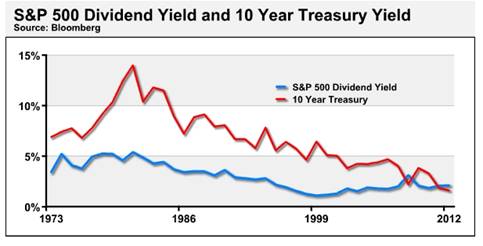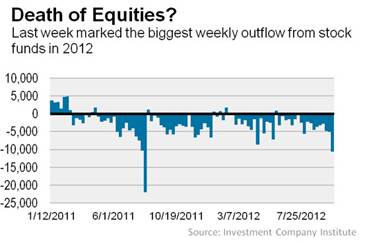Gold And The Disappearing Yield, Death of Equities?
Stock-Markets / Financial Markets 2012 Oct 15, 2012 - 02:35 AM GMTBy: Darryl_R_Schoon
 Traditionally, when economies expanded stocks outperformed bonds; but these aren’t traditional times and although economies have expanded, over the past 30 years bonds have outperformed stocks.
Traditionally, when economies expanded stocks outperformed bonds; but these aren’t traditional times and although economies have expanded, over the past 30 years bonds have outperformed stocks.
Since 1981 the return on long-term government bonds averaged 11.5 %. The S&P stock index averaged 10.8 %; and, since 2000, the returns of stocks over bonds have widened. A major reason why bonds have done better is that since 1982 government bond yields have been declining; and when bond yields decline, bond profits rise.
From Dec. 31, 1999, through May 29, 2012, the Barclays Capital U.S. Aggregate bond index - which covers the investment-grade bond market, including government and corporate bonds as well as mortgage- and other asset-backed securities - returned 104.1 percent to investors. By comparison, the total return of the S&P 500 was 14.2 percent, including share price gains and dividends.
http://finance.yahoo.com/news/big-conundrum-stocks-bonds-120350432.html
With bond investing, the basic principle is that interest rates and prices move in an inverse relationship. When interest rates went from 4.78% to 6.75%, that represented an increase in yield of over 40% [and] the price of the bond declined by a corresponding amount. On the other hand, when interest rates decline, then the price of the bond goes up.
http://www.aaii.com/investing/article/3-why-bond-prices-go-up-and-down

Today, with bond yields near zero, yields can’t go much lower which means bond profits can’t rise as they once did. Yet, despite today’s outlook for lower bond profits, investors are increasingly buying bonds, not for profit but for safety.
INVESTORS ARE SPOOKED, RISK IS BACK IN TOWN
In January 2008, in The Economy and the Fat Kid, I wrote:
… one day, a fat kid shows up at the playground. While everyone knows it’s a private playground and admittance is strictly controlled, no one knows where the fat kid came from or how he got in. Nonetheless, the fat kid’s there.
Then the fat kid walks over to the teeter-totter and sits down. The fat kid’s end of the teeter-totter slams to the ground as the other end skyrockets up; tossing all those on the high end off. The name of the fat kid is risk.
DON’T BLAME THE FAT KID: THE ROLE OF RISK IN FREE MARKETS
…Between 2002 and 2007, risk went into hiding as central banks flooded the markets with cheap money; allowing capital flows to mask losses while boosting asset values to record levels. Billions of dollars of central bank credit translated into trillions of dollars of leveraged bets creating bubbles in all asset classes—real estate, stocks, commodities, and bonds.
… But global market risks, temporarily hidden by cheap credit, have now reasserted themselves with a vengeance… Risk is back and no matter how often the playground supervisor tries to reassure us, we know the playground is no longer safe. Even the big kids are getting hurt. The fat kid’s back and so is the whiff of deflation.
RISK IS IN THE HOUSE
LIBOR’s getting high
As central bankers try
To calm the markets down
But risk is back in town
Risk is in the house Yo!
Risk is in the house
Credit lines are drawn
Where’s the money gone
Spreads are growing fast
Markets sucking gas
Risk is in the house Yo!
Risk is in the house
Triple A means squat
Commercial paper rots
Monolines are down
‘Cause risk is back in town
Risk is in the house Yo!
Risk is in the house
Risk is going ‘round
Can you hear the sound
As tranches hit the ground
‘Cause risk is back in town
Despite today’s high stock markets’ valuations, investors are withdrawing money from stock markets in increasing numbers and are instead buying bonds. These are today’s bond lemmings, bond buyers bound together in the deluded belief that bonds are safe. They are not.
On October 11, 2012, a Wall Street Journal blogger wrote: …investors pulled $10.6 billion out of stock funds in the week ended Oct. … That was the biggest weekly outflow of the year and the largest since August 2011…
.
The total outflow from US stock market funds
for 2012 now exceeds $100 billion
ASIANS PREFER BONDS
Bond flows hit five-year highs among Asian investors was posted October 4, 2012 by Emily Blewett at Citywire Global:
Gross sales into bond funds made up 68% of the industry in the first seven months to July this year whilst 21% were made up of equities. This shows a turnaround in investor sentiment from 2008 when 64% of gross sales went to equities and only 16% to bond funds in the twelve month period.
As global risks increase, investor appetite for bonds in both Asia and the West are growing as the search for safety is now paramount; but investors are mistaken that bonds are safe. They’re not
DEFLATION: THE DAISY CHAIN OF DEBT AND DEFAULTS
Collective slowing global demand is a sign that deflation has now metastasized. Japan is contracting, Europe is contracting, China is slowing and the US is desperately hoping it can print enough money to escape deflation’s growing grasp. It can’t.
A collective collapse in global demand is what happened during the Great Depression. It’s happening again today. The trillions of dollars governments printed and spent since 2008 only delayed the inevitable but did not prevent it; and, now in 2012, the inevitable has once again resumed its deflationary descent.
Most stocks and bonds will not survive the coming rendering. Stocks thrive on growth and the only possible growth now is debt; and bonds are IOUs, debts and obligations contracted in better times when the odds of repayment were more favorable. Today, the odds are less favorable. Tomorrow, they will be worse.
Once underway, deflation’s momentum is impossible to reverse. Nothing central bankers did during the Great Depression revived private demand; and the trillions of dollars being printed today to hopefully do so will be no more successful than were efforts in the 1930s.
What will result from today’s simultaneous central bank monetary easing is massive currency debasement and the buildup of inflationary pressures more than capable of crossing hyperinflation’s invisible line.
GOLD: THE PALLIATIVE FOR DEFLATION AND INFLATION
In the endgame of the bankers’ credit and debt ponzi scheme, gold is the ultimate two-edge hedge. Gold protects against both inflation and deflation. The following excerpt is from my book, Time of the Vulture: How to Survive the Crisis and Prosper in the Process
Gold today is valued primarily as an inflation hedge. That is so because when inflation took hold in the 1970s, gold exploded upwards, rising from $35 per ounce in 1972 to $850 per ounce in 1980, an increase of 2,428% in just eight years.
…What is equally as important, however, is what happened to gold during the Great Depression, the period when deflation stopped the US and world economy dead in its tracks… If, in 1928, $100,000 had been invested in the Dow, in 1938 the investment would have been worth only $10,000. If, however, that $100,000 had been invested in gold mining stocks, the investment would have increased to $1,000,000 by 1938.
p. 29, Time of the Vulture: How to Survive the Crisis and Prosper in the Process, 3rd ed., 2012
Note: Shares in Homestake Mining, the largest gold mining company in the world, were $4.19 in 1929. In 1935, shares were $495 and paid a $56 dividend.
For those attached to today’s markets, to both their opportunities and inequities, the coming collapse is not a welcome event. For those expecting the better world that will come, the coming collapse is merely a necessary transition to better times.
My video, America, Version 1.0, 1.2 and 1.3, discusses the America of the past, present and future. America 1.3 is going to be a lot more like America 1.0.
Buy gold, buy silver, have faith
By Darryl Robert Schoon
www.survivethecrisis.com
www.drschoon.com
blog www.posdev.net
About Darryl Robert Schoon
In college, I majored in political science with a focus on East Asia (B.A. University of California at Davis, 1966). My in-depth study of economics did not occur until much later.
In the 1990s, I became curious about the Great Depression and in the course of my study, I realized that most of my preconceptions about money and the economy were just that - preconceptions. I, like most others, did not really understand the nature of money and the economy. Now, I have some insights and answers about these critical matters.
In October 2005, Marshall Thurber, a close friend from law school convened The Positive Deviant Network (the PDN), a group of individuals whom Marshall believed to be "out-of-the-box" thinkers and I was asked to join. The PDN became a major catalyst in my writings on economic issues.
When I discovered others in the PDN shared my concerns about the US economy, I began writing down my thoughts. In March 2007 I presented my findings to the Positive Deviant Network in the form of an in-depth 148- page analysis, " How to Survive the Crisis and Prosper In The Process. "
The reception to my presentation, though controversial, generated a significant amount of interest; and in May 2007, "How To Survive The Crisis And Prosper In The Process" was made available at www.survivethecrisis.com and I began writing articles on economic issues.
The interest in the book and my writings has been gratifying. During its first two months, www.survivethecrisis.com was accessed by over 10,000 viewers from 93 countries. Clearly, we had struck a chord and www.drschoon.com , has been created to address this interest.
Darryl R Schoon Archive |
© 2005-2022 http://www.MarketOracle.co.uk - The Market Oracle is a FREE Daily Financial Markets Analysis & Forecasting online publication.



